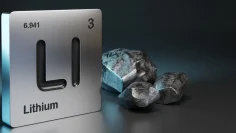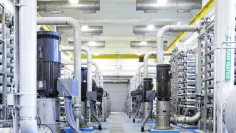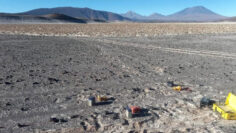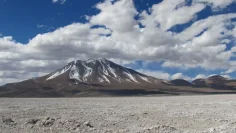{kanada_flagge}Lithium is one of the key drivers of the mobility and energy transition. Demand is expected to quadruple in the next ten years. Experts agree that all available deposit types need to be developed: brine deposits, hard rock deposits, and clay deposits (for example, in Nevada), with no economic precursor yet for the latter. Currently, brine deposits are being bought by large Chinese corporations for big money in Argentina, Chile and USA. But judging by declining share prices, these projects now seem to have a harder time with investors, while the pendulum of investor favor is swinging toward hard-rock projects, some of which have performed like a dream (see Patriot Battery Metals; TSXV: PMET).
The bottom line is that the success of lithium salar projects in South America and elsewhere depends significantly on the development of new DLE technologies. Without this alternative, projects will struggle to compete with hard rock projects – even though they have a clear advantage in terms of resource determination. While hundreds of drill holes are often required for resource determination in hard rock, half a dozen drill holes are often sufficient in salars because the lithium is already dissolved in brine and the lithologies are flat lying lake sediments. If (in the future) no evaporation ponds are needed, the impact on the landscape or on the water balance will be just as small or smaller than with underground mines. It is not for nothing that large companies in particular are investing billions in DLE development. The Ekosolve approach has been prepared for years at the University of Melbourne. Behind it are world-leading experts in their field. In Ekosolve’s favor is the fact that the otherwise necessary pre-cleaning magnesium removal of the brine is eliminated and that the majority (95%) of the solvents can be recovered with minimal water consumption. This sounds like the Egg of Columbus, but again, no such plant is yet operating under commercial conditions, however there are more than 1,000 large commercial solvent exchange plants working in uranium and copper around the world. Still, the combination of technology and resource is exciting. As of now, under Phil Thomas, Canadian lithium explorer Spey Resources stands as both: a bet on an early first lithium resource from its Argentine salar and a technology that, if successful, could redefine the lithium sector.
{kanada_flagge}Lithium is one of the key drivers of the mobility and energy transition. Demand is expected to quadruple in the next ten years. Experts agree that all available deposit types need to be developed: brine deposits, hard rock deposits, and clay deposits (for example, in Nevada), with no economic precursor yet for the latter. Currently, brine deposits are being bought by large Chinese corporations for big money in Argentina, Chile and USA. But judging by declining share prices, these projects now seem to have a harder time with investors, while the pendulum of investor favor is swinging toward hard-rock projects, some of which have performed like a dream (see Patriot Battery Metals; TSXV: PMET).
The hard-rock lithium lobby has been cleverly framing itself against lithium brine projects. The recurring arguments are that brine projects are mostly in South America, making them politically unsafe. Hard rock projects also exist in politically safe countries such as the U.S., Canada or Australia. The second, more important objection to brine projects is that they interfere with the delicate water balance because they are located in the desert. This makes the development of conventional evaporation ponds difficult from an environmental point of view.
In fact, lithium extraction from brine if not using a DLE (Direct lithium extraction method) currently still requires the construction of large ponds and the use of large quantities of lithium brine, which destabilizes the water table, takes years to build and commission. At best, these methods recover only 55 to 70 percent of the lithium contained in the brines, resulting in significant losses of this valuable resource.
University of Melbourne unveils new Direct Lithium Extraction (DLE) process EkoSolve™
This is exactly where DLE comes in. Around the world, technical solutions are being worked on at full speed: BMW, Livent and and BASF are working together on a salar in South America; leading Chilean lithium producer SQM plans to spend an estimated $1.5 billion on the world’s largest DLE plant. Meanwhile, all possible technical variants are being tested: from solvent extraction, adsorption, ion exchange to membranes. Eventually, extraction should take only hours, not weeks, and require less water. The problem with all DLE technologies is that there is not yet a commercial success story.
With dozens of competing DLE approaches now, it’s not easy to keep track. But from Australia comes a technology that seems particularly promising. Developed over several years by researchers in the Department of Chemical Engineering at the Advanced Separations Technologies Group at the University of Melbourne, Australia, led by Laureate Professor Dr. Geoff Stevens AO and Associate Professor Dr. Kathryn Mumford in collaboration with research company Ekos Research, the Ekosolve™ process yields a lithium product of 99.5 percent purity, recovered in just 1 to 2 hours. In the process, 95 percent of the solvent is recovered and very little fresh water is required. The University owns the Licence and Ekosolve Limited has the exclusive world wide rights to licence the technology to producers. Ekosolve Limited has signed two contracts and has four pending and is soon to list the public company.
Ekosolve’s direct solvent extraction process quickly produces a high-purity product with a much lower environmental impact and a greener footprint. It also has no negative impact on the people living in the remote regions where these brines are found. Ekosolve could play a key role in providing a more efficient, environmentally friendly process for producing lithium carbonate. According to reports, several customers have already committed to adopting the Direct Lithium Extraction solvent extraction process.
Proven solvent exchange technology provides the basis
The process is based on the proven principles of solvent exchange and involves a solution that directly targets and extracts the lithium before it can be separated and purified. Salt water is pumped from the salars, mixed with the developed solvents to form a phase, then – thanks to the solvent design – the lithium migrates from the brine into the solvent. After a short time, (22 seconds) the two liquids (like oil and water) separate and the solvent, which now contains the lithium, is separated from the brine by density differences. The lithium is then dissolved from the solvent and crystallizes. What remains is solid lithium chloride or, with the addition of sodium carbonate, lithium carbonate, which can be used for batteries. is the entire process,” says Dr. Mumford.
The development of Ekosolve™ began when Ekos Research approached the University of Melbourne Advanced Separations Technologies Group. They wanted to know if the new solvent extraction method was suitable for the particular salars. These were Rincon, Pocitos, Rio Grande, Incahuasi and Pozuelos in Argentina. After about 18 months, the process looked very promising, so a formal licencing partnership was formed. Over the next four years, Dr. Sorentino, Phillip Thomas, CEO of Ekosolve Limited, and the university conducted further research and development to develop the specific Ekosolve™ technology. In 2022, the technology was licensed to the (still private) unlisted public Australian company Ekosolve Limited.
Other points that make Ekosolve™ attractive to lithium producers are comparatively low capital and operating costs. In particular, the process eliminates the need for costly front-end scrubbing to remove magnesium and calcium to prepare the brine for processing, which is the major drawback with most other technologies.
Dr. Carlos Sorentino, chief technical officer at Ekos Research and at Ekosolve Limited, the private company formed to commercialize the technology, said, “Lithium has been extracted from brines since about 1970. But conventional methods are wasteful. Our process improves yields by about 50 percent and doesn’t affect water supplies. One thing that excites me is the ability to produce from salars with very low lithium concentrations and high magnesium to lithium ratios. Ekosolve™ makes it profitable.”
Samples of lithium salars from Spey Resources’ project portfolio successfully tested
Ekosolve Limited’s first customer is lithium explorer Spey Resources (TSXV: SPEY; FRA: 2JS), where Phil Thomas also assumed the role of CEO last week. Final testing is currently underway for a larger 100 tonne mini plant. If successful, a much larger plant to be deployed directly in the salars in South America for customer Spey Resources on the Incahuasi or Pocitos salars. Brines from Spey’s Incahuasi salar have already been tested successfully in the University of Melbourne pilot plant.
The bottom line is that the success of lithium salar projects in South America and elsewhere depends significantly on the development of new DLE technologies. Without this alternative, projects will struggle to compete with hard rock projects – even though they have a clear advantage in terms of resource determination. While hundreds of drill holes are often required for resource determination in hard rock, half a dozen drill holes are often sufficient in salars because the lithium is already dissolved in brine and the lithologies are flat lying lake sediments. If (in the future) no evaporation ponds are needed, the impact on the landscape or on the water balance will be just as small or smaller than with underground mines. It is not for nothing that large companies in particular are investing billions in DLE development. The Ekosolve approach has been prepared for years at the University of Melbourne. Behind it are world-leading experts in their field. In Ekosolve’s favor is the fact that the otherwise necessary pre-cleaning magnesium removal of the brine is eliminated and that the majority (95%) of the solvents can be recovered with minimal water consumption. This sounds like the Egg of Columbus, but again, no such plant is yet operating under commercial conditions, however there are more than 1,000 large commercial solvent exchange plants working in uranium and copper around the world. Still, the combination of technology and resource is exciting. As of now, under Phil Thomas, Canadian lithium explorer Spey Resources stands as both: a bet on an early first lithium resource from its Argentine salar and a technology that, if successful, could redefine the lithium sector.
Disclaimer: GOLDINVEST Consulting GmbH publishes comments, analyses and news on https://goldinvest.de. These contents serve exclusively the information of the readers and do not represent any kind of call to action, neither explicitly nor implicitly they are to be understood as an assurance of possible price developments. Furthermore, they do not in any way replace individual expert investment advice and do not constitute an offer to sell the stock(s) discussed or a solicitation to buy or sell securities. This is expressly not a financial analysis, but an advertising / journalistic text. Readers who make investment decisions or carry out transactions on the basis of the information provided here do so entirely at their own risk. There is no contractual relationship between the GOLDINVEST Consulting GmbH and its readers or the users of its offers, because our information refers only to the company, but not to the investment decision of the reader.
The acquisition of securities involves high risks, which can lead to a total loss of the invested capital. The information published by GOLDINVEST Consulting GmbH and its authors is based on careful research. Nevertheless, any liability for financial losses or the content guarantee for topicality, correctness, adequacy and completeness of the articles offered here is expressly excluded. Please also note our terms of use.
According to §34b WpHG and § 48f Abs. 5 BörseG (Austria) we would like to point out that GOLDINVEST Consulting GmbH and/or partners, principals or employees of GOLDINVEST Consulting GmbH hold shares in both Spey Resources and therefore a conflict of interest exists. GOLDINVEST Consulting GmbH also reserves the right to buy or sell shares of the companies at any time, which could have an impact on the price of the shares. Furthermore, GOLDINVEST Consulting GmbH is remunerated by Spey Resources for reporting on the company. This is another clear conflict of interest.











